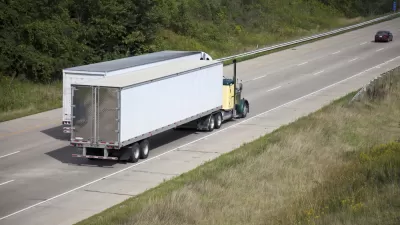All but nine states have decreased the number of "structurally deficient" bridges since the 2007 Minneapolis bridge collapse. That improvement, however, is far from permanent. Can the federal government and states maintain their progress?
"The number of bridges considered to be in the worst shape has declined in the vast majority of states — all but nine — in the years since a Minneapolis bridge collapse brought national attention to the America’s decaying bridges," reports Daniel Vock.
"All told, the number of 'structurally deficient' bridges dipped by 14 percent in the last six years. But even with the improvement, one in 10 bridges in the country is still considered structurally deficient."
The article credits public attention after the Minneapolis bridge collapse, as well as federal policies to better manage the inventory of bridges and roads, with the improvement.
But, "[the] federal surface transportation law expires this fall, and federal transportation money to states may dry up even before that. If Congress does not find the money to continue or increase current funding levels, the number of troubled bridges could start climbing again."
The article also includes a state-by-state breakdown of where the improvements have been most, or least, profound.
FULL STORY: Under Scrutiny, States Trim List of Bad Bridges

Planetizen Federal Action Tracker
A weekly monitor of how Trump’s orders and actions are impacting planners and planning in America.

Restaurant Patios Were a Pandemic Win — Why Were They so Hard to Keep?
Social distancing requirements and changes in travel patterns prompted cities to pilot new uses for street and sidewalk space. Then it got complicated.

Map: Where Senate Republicans Want to Sell Your Public Lands
For public land advocates, the Senate Republicans’ proposal to sell millions of acres of public land in the West is “the biggest fight of their careers.”

Maui's Vacation Rental Debate Turns Ugly
Verbal attacks, misinformation campaigns and fistfights plague a high-stakes debate to convert thousands of vacation rentals into long-term housing.

San Francisco Suspends Traffic Calming Amidst Record Deaths
Citing “a challenging fiscal landscape,” the city will cease the program on the heels of 42 traffic deaths, including 24 pedestrians.

California Homeless Arrests, Citations Spike After Ruling
An investigation reveals that anti-homeless actions increased up to 500% after Grants Pass v. Johnson — even in cities claiming no policy change.
Urban Design for Planners 1: Software Tools
This six-course series explores essential urban design concepts using open source software and equips planners with the tools they need to participate fully in the urban design process.
Planning for Universal Design
Learn the tools for implementing Universal Design in planning regulations.
Heyer Gruel & Associates PA
JM Goldson LLC
Custer County Colorado
City of Camden Redevelopment Agency
City of Astoria
Transportation Research & Education Center (TREC) at Portland State University
Camden Redevelopment Agency
City of Claremont
Municipality of Princeton (NJ)




























